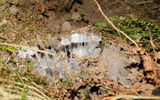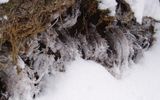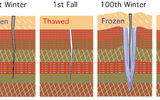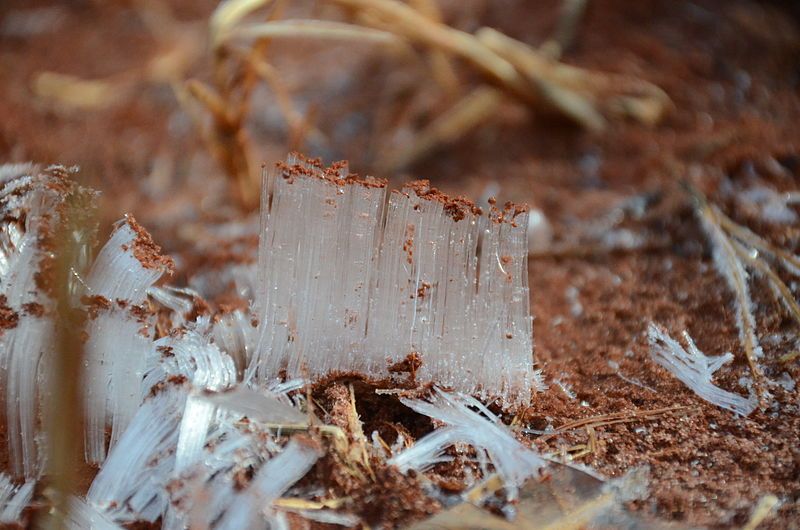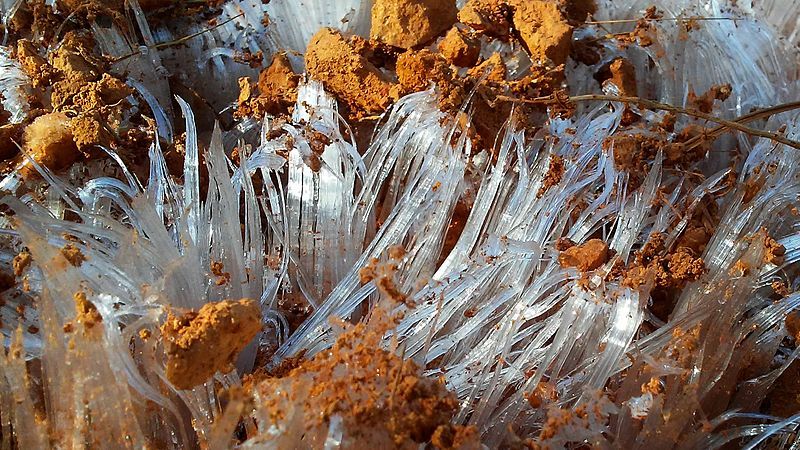
| Added | Wed, 30/12/2020 |
| Sources | |
| Феномены | |
| Version type |
"Needle ice" is a needle-shaped column of ice formed by ground water. It is formed when the temperature in the soil is above 0°C (32°F), and the air surface temperature is below 0°C (32°F).
Underground liquid water rises to the surface under the action of capillaries, and then freezes and promotes the growth of a needle-like column of ice.
Needle ice requires the presence of flowing water under the surface, from which point it comes into contact with air whose temperature is below zero. This area of the process usually occurs at night, when the temperature reaches its lowest point. Since then, it has produced a needle-like structure.
These ice needles are typically a few centimeters in length. During their growth they can raise or repel the fine particles of the soil. On sloping surfaces, needle ice can be a contributing factor to soil creep.
Alternative names are "Needle ice", "frost pillars" ("Säuleneis" in Germany), "frost column", "Kammeis" (the German term "comb ice"), "Stängeleis" (another German term referring to the stock as a structure), "shimobashira" (霜柱, a Japanese term meaning ice pillars), "pipkrake" (from Swedish pipa (tube) and krake (weak, thin), invented in 1907 by Henrik Hesselman).
For needle ice to form, there must be a process of ice segregation that occurs only in a porous medium when supercooled water freezes into existing ice growing from the ice / water interface. As water penetrates the ice, it splits into individual pieces of ice in the form of lenses, ribbons, needles, layers or strands of ice.
Needle ice is commonly found along stream banks or soil terraces. It is also found in gaps around rocks and other areas of patterned earth. The variety of soil properties also affects where it is located.
Places where the soil is much deeper and richer can affect the growth of ice. Consequently, the deeper the soil, the more water allows it to develop. Obviously, it can form wherever groundwater is exposed to open (freezing) air.
Needle ice is best suited for soils with a high content of silt and organic matter. Needle ice consists of groups of narrow pieces of ice up to several centimeters long. The largest recorded needle ice was 10 cm long.
Needle ice slowly grows from moist and permeable soil and gradually melts in the sun. It may vary in appearance, but always shows a constant growth of ice perpendicular to the surface of the earth. Needle ice looks like a bundle of filamentous crystals and has a straight or curved shape. It usually forms in the morning when the temperature drops below freezing (0°C).
The appearance of needle ice was recognized as a geomorphic factor of soil disturbance, causing the appearance of a number of small-scale landforms.
Needle ice phenomena play a particularly important role in patterned ground in a periglacial environment.
The growth of needle ice raises the exfoliated crust of frozen ground moving on top of the ice layer. When the crust and ice melt, the soil surface settles unevenly. This phenomenon is associated with erosion, especially in riverbeds.
Needle ice tends to move rocks in the soil up to the surface and move rocks on the surface to nearby depressions. Depressions caused by needle ice activity are known as ice pans, and lumps caused by needle ice are known as "bumps".
Similar phenomena can occur on living or dead plants, especially on wood. They are usually called ice flowers.
Log in or register to post comments

